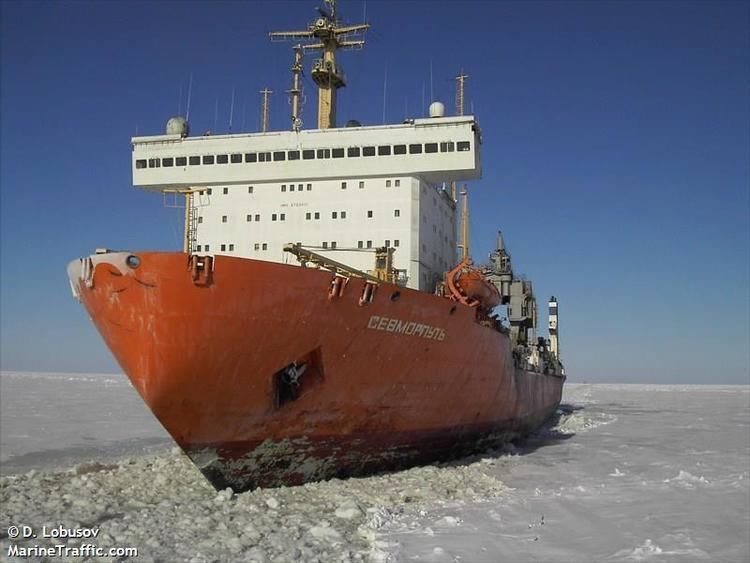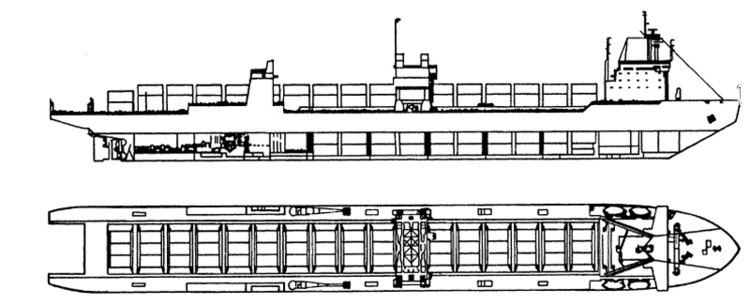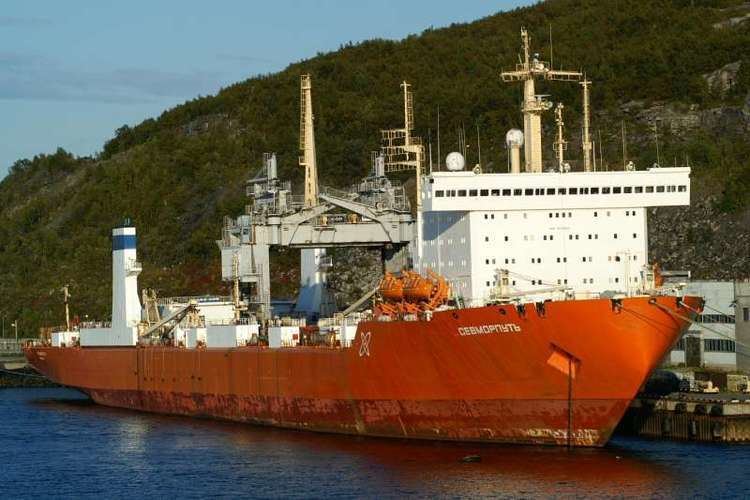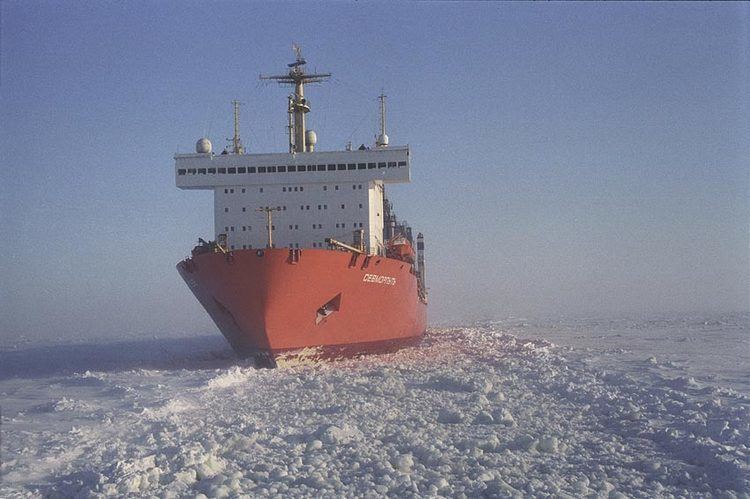Name Sevmorput (Севморпуть) Ordered 30 May 1978 Launched 20 February 1986 | Namesake Severny Morskoy Put Port of registry Murmansk, Russia Construction started 1 June 1982 Length 260 m | |
 | ||
Builders Zalyv Shipbuilding yard, Kerch | ||
Sevmorput (Russian: Севморпуть; [sʲɪvmɐrˈputʲ]) is a Russian nuclear-powered icebreaking LASH carrier and container ship. Named after the Northern Sea Route (Russian: Северный Морской Путь, Severny Morskoy Put), the 1988-built ship is one of only four nuclear-powered merchant ships ever built.
Contents
- Development and construction
- Career
- General characteristics
- Power and propulsion
- Cargo capacity and handling
- References
In October 2012, it was reported that Sevmorput would be decommissioned and sold for scrap, but this decision was reversed in December 2013. Sevmorput was laid up at the Atomflot base near Murmansk, Russia, until 2015 when she was returned to operational condition.

Development and construction

The history of Sevmorput dates back to a joint decision by the Ministry of the Merchant Marine (MORFLOT) and the Ministry of Shipbuilding Industry of the Soviet Union, No C-13/01360, which was signed on 30 May 1978. Following the development of heavy industry in the northern parts of the country, particularly around Norilsk, a reliable transportation method was needed to guarantee year-round shipments of cargo and supplies to and from the northern communities. Experiences from the nuclear icebreakers operating on the Northern Sea Route since the mid-1950s had shown the advantages of nuclear marine propulsion in the ice-infested waters of the Russian Arctic. Thus a decision was made to construct a new icebreaking LASH carrier, capable of serving high-volume shallow ports, that was powered by a nuclear reactor. The ship was designed by the Baltsudoproect Central Design Bureau.

The keel of Sevmorput was laid on 1 June 1982 at Zaliv shipyard in Kerch, Ukraine, at the time part of the Soviet Union. She was launched on 20 February 1986 and delivered to state-owned Murmansk Shipping Company (MSCO) on 31 December 1988. After leaving the shipyard Sevmorput sailed through the Mediterranean and around Africa until finally reaching the Soviet Far East.
The overall price of the nuclear-powered cargo ship was reported to be around US$265 million.
Career

After entering service Sevmorput was denied entry to four major ports in the Soviet Far East. Authorities in Nakhodka, Vostochny, Magadan and Vladivostok refused to accept the two-month-old ship into their ports due to popular protests. In addition the harbour workers also refused to load or unload any cargo or provide any port services due to fears of radiation leakage. This was caused by uncertainty about the safety of the ship's nuclear propulsion system and the shadow of the Chernobyl disaster only few years earlier. The local newspapers had also reported a four-minute emergency on board the nuclear icebreaker Rossiya only a week before the arrival of Sevmorput. The ship was finally allowed to dock at Vladivostok on 13 March 1989.
The initial plan was to utilize Sevmorput in international transport, and the Soviet government applied for a permission to have the ship make several stops in Vancouver, Canada, in March 1990. However, the permission was denied because the evacuation and emergency response measures of the city were not deemed adequate in case of an accident involving the ship's nuclear reactor. Later the ship was mainly used on the Murmansk-Dudinka route, but also made several trips to Vietnam in the early 1990s. The daily operating expenses of Sevmorput were reportedly around US$90,000 and she was not expected to make profit during the first two years of her career.
In the late 1990s, Sevmorput was laid up in Murmansk due to delays in the refueling of her reactor. The refueling finally took place in 2001 and later the ship resumed service on the Dudinka route.
In August 2007, it was reported that Sevmorput would be converted into the world's first nuclear-powered drillship due to lack of demand for cargo operators for lighters and the need of specialized drilling vessels in the Russian Arctic. The conversion at the Zvezdochka plant in Severodvinsk was to take only 18 months. However, the renovation project was revoked in February 2008.
The management of the Russian nuclear-powered icebreaker fleet was transferred from MSCO to Rosatom in 2008. In October 2009, the general director of Atomflot announced that Sevmorput could remain in service for 15 years.
In late October 2012, it was reported that Sevmorput, which had been lying idle at the Atomflot base outside Murmansk since 2007, had been removed from the Russian Ship Register in July and would be sold for scrap. However, in December 2013 it was reported that the decision to decommission the nuclear-powered ship had been cancelled and that the vessel would be brought back to service by February 2016. In November 2015, Sevmorput left Murmansk for the first time in years to carry out sea trials in the Barents Sea. The vessel began loading its first cargo for nearly ten years, building materials for a new military base in the Kotelny Island, in May 2016. During the week-long voyage from Murmansk, Sevmorput will be escorted by the nuclear-powered icebreaker Yamal.
General characteristics
Sevmorput is 260.30 metres (854.0 ft) long overall and 236.60 metres (776.2 ft) between perpendiculars. The breadth and depth of her hull are 32.20 metres (105.6 ft) and 18.30 metres (60.0 ft), respectively. When loaded to the summer waterline, the ship draws 11.80 metres (38.7 ft) of water. However, in ice-infested waters she operates with a slightly smaller draught of 10.65 metres (34.9 ft) to improve the icebreaking characteristics of her raked stem. The gross tonnage of Sevmorput is 38,226 and net tonnage 11,468. The ship's deadweight tonnage is 33,980 tons at maximum draught and 26,480 tons while operating at reduced draught in ice. Her maximum displacement is 61,880 tons.
Although originally designed according to the USSR Register of Shipping rules of 1981 to the highest Soviet ice class available for merchant ships, ULA, Sevmorput is currently classified by the Russian Maritime Register of Shipping with a slightly lower ice class, UL. In addition to the national rules she was built according to the latest international regulations and conventions at the time, becoming the first ship built according to the Code of Safety for Nuclear Merchant Ships adopted by the International Maritime Organization in 1981. Special attention was paid to the safety aspects of the vessel and, in addition to running aground or colliding with the reinforced bow of an icebreaker, the Soviet naval architects even took into account the possibility of a passenger aircraft crashing on Sevmorput.
Power and propulsion
Sevmorput is powered by a single KLT-40 nuclear fission reactor with a thermal output of 135 megawatts. The reactor core contains 150.7 kilograms (332 lb) of 30–40- or 90-percent enriched uranium in uranium-zirconium alloy and has required refueling only once. The nuclear power plant on board the vessel produces 215 tons of steam per hour at a pressure level of 40 atm (4,100 kPa) and temperature of 290 °C (554 °F). In case of emergency steam can also be produced by a diesel-powered boiler (50 t/h, 2,450 kPa, 360 °C).
Unlike the Russian Arktika and Taymyr class nuclear icebreakers, which have three fixed-pitch propellers and utilize nuclear-turbo-electric powertrain, Sevmorput is propelled by a single 4-bladed ducted controllable-pitch propeller mechanically coupled to a steam turbine, GTZA 684 OM5, which has a maximum output of 29,420 kW (39,450 hp) and turns the 6.7-metre (22 ft) propeller at 115 rpm. At full power the propulsion system gives the ship a maximum speed of 20.8 knots (38.5 km/h; 23.9 mph) at a draught of 10 metres (33 ft). She can also maintain a speed of 2 knots (3.7 km/h; 2.3 mph) in 1-metre (3.3 ft) thick level ice.
For electricity production Sevmorput has three 1,700 kW turbogenerators and three 2,000 kW standby diesel generators. In addition in case of blackout the vessel also has two 200 kW emergency diesel generators.
Cargo capacity and handling
Sevmorput can carry 74 lighters, each with a cargo capacity of 300 tons, in six holds and in two layers on the stern deck. The cargo hold hatches are designed for lighters with a total weight of 450 tons. The lighters are loaded and unloaded with a large gantry crane, manufactured by KONE, with a span of 21.3 metres (70 ft) and lifting capacity of 500 tons. The gantry crane has two three-ton auxiliary cranes.
When not carrying lighters, Sevmorput can carry both 20- and 40-foot containers weighing up to 20.3 and 30.5 tons, respectively, in three layers. The total container capacity of the ship is 1,328 twenty-foot equivalent units (TEU). While loading and unloading are usually done by shore-based cranes, a small number of containers can be handled with two container attachments to the gantry crane in ports that do not have cranes capable of handling containers. The lifting capacity of the attachments is 38 tons. In addition, the vessel has two 16-ton and two 3.2-ton cranes.
